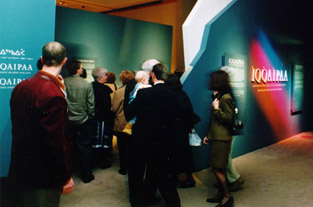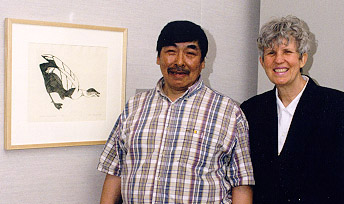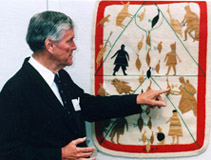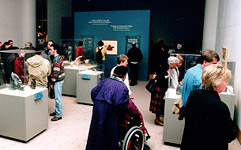 April 1, 1999 to February 6, 2000 About the Exhibition
Presented by Cancom, Iqqaipaa: Celebrating Inuit Art, 1948-1970 was an exhibition of more than 150 works, designed not only to pay tribute to Inuit art but also to explore its origins. The exhibition told the fascinating story of a culture in turmoil and transition out of which a distinctive and important artistic movement was born. Iqqaipaa: Celebrating Inuit Art, 1948-1970 demonstrated how art making not only provided a welcome income to individuals and communities after the traditional economy had collapsed, but also eased the transition from camp to settlement life by providing a sense of pride and cultural identity in the face of overwhelming acculturation. The exhibition ran from April 1, 1999 to February 6, 2000. Accessibility
Resource CentreThe exhibition also featured a multimedia resource centre where viewers could browse for information on individual artists, their works of art, and their quotes and remembrances about this time of transition in their lives. This user-friendly resource centre aimed to encourage visitors to expand their knowledge of the roots and development of Inuit art and to lead them to deepen their appreciation of the art itself. The CollectionAll but twenty of the works of art in the exhibition came from the unparalleled collection of the Canadian Museum of Civilization (CMC), many never before been publicly displayed. Forty-six of the art works were once part of the significant Department of Indian and Northern Affairs collection that was divided in 1989. The twenty pieces not belonging to the Museum were on loan from James Houston's personal collection. Houston, who worked as special advisor to the exhibition team, acquired part of his collection as early as fifty years ago when he travelled and lived in the North. The prolific designer, author and filmmaker is perhaps best known as a promoter of Inuit art, having encouraged art making in several Inuit communities and having made the world aware of this exciting artistic movement.
Maria von Finckenstein, Exhibition CuratorCurator of Contemporary Inuit Art, Canadian Museum of Civilization 
Maria von Finckenstein has been associated with Inuit art for more than twenty years. After studying art history in Bonn, Vienna and Berlin, she graduated from McGill University. During a fourteen-year tenure at the Department of Indian and Northern Affairs (DIAND), she was curator of the Department's Inuit art collection of 5,000 pieces and later head of the Inuit Art Section. Artist Kananginak Pootoogook and Maria von Finckenstein. Photographer: Steven Darby, Canadian Museum of Civilization As curator, Ms. von Finckenstein produced, co-produced, and collaborated on a series of travelling exhibitions, including Arctic Vision, Chisel and Brush and In the Shadow of the Sun. As section head, she was instrumental in setting up the Inuit Art Foundation, an arm's-length agency directed by an all-Inuit board, with the mandate of providing professional development for artists from the Northwest Territories, Nunavik (Northern Quebec) and Labrador. Ms. von Finckenstein's writing has appeared in numerous publications on Inuit art and she is a regular contributor to the magazine Inuit Art Quarterly.
James Houston, Special AdvisorO.C., D.Litt., D.H.L., D.F.A., L.L.D., F.R.S.A., F.R.C.G.S. James Houston, author, designer and filmmaker, was born in 1921. He studied in Canada, Europe and Japan, and throughout the Second World War he served with the Toronto Scottish Regiment. In 1948, he went to the Eastern Arctic to paint and remained there for twelve years, nine of them as a Northern Service Officer and the remainder as Civil Administrator of west Baffin Island, a territory of 65,000 square miles. Houston was a prime force in the recognition of Inuit art, and while living at Cape Dorset he introduced printmaking to the Inuit. He is past Chairman of both the Canadian Eskimo Arts Council and the American Indian Art Center, and he is presently on the Inuit Art Selection Committee of the Canadian Museum of Civilization. 
Mr. Houston divides his time between his home in Stonington, Connecticut, a writing and fishing retreat on the Queen Charlotte Islands, British Columbia, and New York City, where he is Master Designer for Steuben Glass. His sculptures, drawings and paintings are in museums and private collections throughout the world. He has produced and directed numerous award-winning documentary films that have been televised around the world. James Houston. Iqqaipaa exhibition. Photographer: Steven Darby, Canadian Museum of Civilization. James Houston most often writes about Northern Indians and Inuit. He is the author and illustrator of 17 books for children, many of which have won international book awards. His novels, The White Dawn, Ghost Fox, Spirit Wrestler, Eagle Song and Running West have been selections of major book clubs and have been published in numerous foreign-language editions. His most recent novel is The Ice Master. His published memoirs are entitled Confessions of an Igloo Dweller and Zigzag: A Life on the Move. Mr. Houston wrote the screenplay for Paramount Pictures' film production of The White Dawn, of which he was Associate Producer. James Houston is an Officer of the Order of Canada and a Fellow of both the Royal Society of Arts and the Royal Canadian Geographical Society and has received numerous other awards and distinctions. Houston DonationIn the course of working on this project, James Houston decided to make a very generous gift to the Museum by donating four pieces from his own collection. Two large sculptures — Tonrak Chief, made in 1964 by Pangnirtung artist Josephee Kakee, and Woman Fishing, 1967, by Margaret Aniksak Uyauperk of Arviat — are included in Iqqaipaa. Houston also donated two untitled drawings by the well-known Cape Dorset artist Kenojuak Ashevak. Photographer: Steven Darby, Canadian Museum of Civilization Credits:
|
